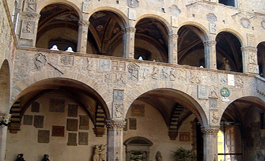|
|
 |
|
FLORENCE TOUR
Florence walking tours are a fundamental part of a visit to this city. You can start at the Accademia, where Michelangelo’s David has resided for over 500 years, traipse down via Ricasoli to the world famous Duomo (and one of the few splashes of color in the city’s architecture, even if is only muted green and red marble), stop at the Uffizi museum to take in one of the largest collection of Renaissance art (bequeathed to the city by the Medici family, is the culmination of three centuries of intrepid art collection and contains work by notable artists such as Da Vinci, Michelangelo and Botticelli), and cross the Arno River at Ponte Vecchio (the shops of Ponte Vecchio attest to the extravagant lifestyle of the city’s past, every shop along the bridge has a few selections that cost more than your first car) before ending your stroll in the Boboli Gardens, an idyllic resting spot originally designed for the Medicis, but has since been commandeered as a playground for hundreds of friendly stray cats.
A complete tour of Florence can be finished in a day or in a month. It depends on how much you enjoy the myriad art exhibits at your disposal.
|
|
 The city, on the banks of the Arno river, originally named FIESOLE, was founded by the Etruscans in about 200BC. The Romans, who displaced the Etruscans, called it FLORENTIA, and used it as a garrison town to control the Via Flaminia a major Roman highway. The city, on the banks of the Arno river, originally named FIESOLE, was founded by the Etruscans in about 200BC. The Romans, who displaced the Etruscans, called it FLORENTIA, and used it as a garrison town to control the Via Flaminia a major Roman highway.
During the 12th and 13th centuries, the city underwent a process of democratization. First, it evolved into a free commune. By 1138 AD, it was ruled by a board of 12 consuls, advised by a wealthy group of merchants, the Council of One Hundred. This arrangement fell apart because of infighting, resulting in the “election” of a foreign governor, the podesta. |
Early in the 13th century, bickering between the Guelphs (pro-papal) and Ghibellines (pro-monarchy), ultimately resulted in the formation of a government by the “winning” Guelphs. During this period, the plague reduced the city’s population by half, which accelerated the democratization process.By the end of the century, nobles were excluded from Florentine government, and the city became a republic, controlled by Guelph merchants. The DeMedici family emerged as the leading family, and the city came more or less under their control until they went broke in 1494, when Florence fell under the control of Girolamo Savanorola, a Dominican munk who enforced a puritanical regime. He was hanged and burned for his troubles in 1498.
|
 The enterprising Medici’s returned to power in the early 16th century and ruled for another 200 years. The city’s fame as a center of art, culture and science derives principally from the fact that the Medicis were active patrons to the best of the best in all fields. This period, with a legacy almost unsurpassed in the western world, is known far and wide as the Renaissance. The enterprising Medici’s returned to power in the early 16th century and ruled for another 200 years. The city’s fame as a center of art, culture and science derives principally from the fact that the Medicis were active patrons to the best of the best in all fields. This period, with a legacy almost unsurpassed in the western world, is known far and wide as the Renaissance.
In the 18th century, the Grand Duchy of Tuskany passed into the control of the House of Lorraine, and was ultimately incorporated into the Kingdom of Italy, of which Tuscany became capital. With the demise of the monarchy, Tuscany became just another, if somewhat more exalted, regional capital.
|
WALKING TOUR
Every imaginable variation of Florence walking tours includes a trip to the Duomo. A wondrous and overwhelming sculpture in the center of town, its giant golden dome is visible all trough Florence.
Restaurants in Florence are beyond compare, and many denizens seem to take more pride in being surrounded by the city’s culinary masterpieces than the artistic ones. Olive oil, Chianti wine, and fresh fish are abundant in both taste and quantities on most Tuscan tables. Fruits and vegetables from the rolling hills of nearby Umbria add flavor and color, while juicy steaks and lively tripe headline the menus of many restaurants in Florence. |
|